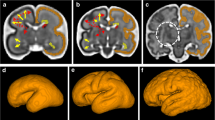Abstract
Cerebral malformations are usually described following the different steps in development. Disorders of neurulation (dysraphisms), or diverticulation (holoprosencephalies and posterior fossa cysts), and total commissural agenesis are usually diagnosed in utero. In contrast, disorders of histogenesis (proliferation-differentiation, migration, organization) are usually discovered in infants and children. The principal clinical symptoms that may be a clue to cerebral malformation include congenital hemiparesis, epilepsy and mental or psychomotor retardation. MRI is the imaging method of choice to assess cerebral malformations.
















Similar content being viewed by others
References
Gupta SN, Brook B, Rishikesh R (2008) Parietal bone defect: differential diagnosis and neurologic associations. Pediatr Neurol 39:40–43
Simon EM, Hevner R, Pinter JD et al (2000) Assessment of the deep gray nuclei in holoprosencephaly. AJNR 21:1955–1961
Hahn JS, Barkovich AJ, Stashinko EE et al (2006) Factor analysis of neuroanatomical and clinical characteristics of holoprosencephaly. Brain Dev 28:413–419
Barkovich AJ (2002) Magnetic resonance imaging: role in the understanding of cerebral malformations. Brain Dev 24:2–12
Davila-Gutierrez G (2002) Agenesis and dysgenesis of the corpus callosum. Semin Pediatr Neurol 9:292–301
Raybaud C, Girard N, Canto-Moreira N et al (1996) High definition magnetic resonance imaging identification of corticl dysplasias (micropolygyria versus lissencephaly). In: Guerrini R, Andermann F, Canapicchi R et al (eds) Dysplasias of cerebral cortex and epilepsy. Lippincot-Raven, Philadelphia, pp 131–143
Guerrini R, Dobyns WB, Barkovich AJ (2008) Abnormal development of the human cerebral cortex: genetics, functional consequences and treatment options. Trends Neurosci 31:154–162
Lisi MT, Cohn RD (2007) Congenital muscular dystrophies: new aspects of an expanding group of disorders. Biochim Biophys Acta 1772:159–172
Dobyns WB, Mirzaa G, Christian SL et al (2008) Consistent chromosome abnormalities identify novel polymicrogyria loci in 1p36.3, 2p16.1-p23.1, 4q21.21-q22.1, 6q26-q27, and 21q2. Am J Med Genet A 146A:1637–1654
Tietjen I, Bodell A, Apse K et al (2007) Comprehensive EMX2 genotyping of a large schizencephaly case series. Am J Med Genet A 143A:1313–1316
Raybaud C, Girard N, Levrier O et al (2001) Schizencephaly: correlation between the lobar topography of the cleft(s) and absence of the septum pellucidum. Childs Nerv Syst 17:217–222
Poretti A, Limperopoulos C, Roulet-Perez E et al (2009) Outcome of severe unilateral cerebellar hypoplasia. Dev Med Child Neurol Oct 23 [Epub ahead of print]
Steinlin M, Klein A, Haas-Lude K et al (2007) Pontocerebellar hypoplasia type 2: variability in clinical and imaging findings. Eur J Paediatr Neurol 11:146–152
Boltshauser E (2001) Cerebellar imaging - an important signpost in paediatric neurology. Child’s Nerv Syst 17:211–216
Ramaekers VT, Heimann G, Reul J et al (1997) Genetic disorders and cerebellar structural abnormalities in childhood. Brain 120:1739–1751
Lee JW, Kim DS, Shim KW et al (2008) Management of intracranial cavernous malformation in pediatric patients. Childs Nerv Syst 24:321–327
Author information
Authors and Affiliations
Corresponding author
Rights and permissions
About this article
Cite this article
Girard, N.J. Cerebral malformations without antenatal diagnosis. Pediatr Radiol 40, 834–843 (2010). https://doi.org/10.1007/s00247-010-1595-9
Received:
Accepted:
Published:
Issue Date:
DOI: https://doi.org/10.1007/s00247-010-1595-9




